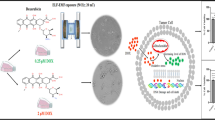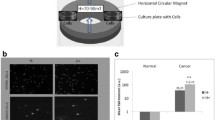Abstract
In this study, we reported the effects of simultaneous application of static magnetic field (SMF) and cisplatin as an anticancer drug on the oxidative stress in human cervical cancer (HeLa) cell line and normal skin fibroblast cells (Hu02). The cells were exposed to different SMF intensities (7, 10, and 15 mT) for 24 and 48 h. IC50 concentrations of cisplatin were obtained by MTT assay. The cytotoxic effects of combined treatment were studied by measuring the intracellular reactive oxygen species content using flow cytometric method and estimation of membrane lipid peroxidation by spectrophotometry. Statistical analysis was assessed using one-way repeated measures analysis of variance (ANOVA) followed by Tukey’s test. Based on the obtained results, the highest and lowest death rate, respectively, in HeLa and Hu02 cell lines was observed at the intensity of 10 mT. Also, we found that membrane lipid peroxidation in cancer cells is higher than that of normal counterparts. SMF potently sensitized human cervical cancer cells to cisplatin through reactive oxygen species (ROS) accumulation while it had small effects on normal cells. The combination of both treatments for 48 h led to a marked decrease in the viability percentage of HeLa cells by about 89% compared to untreated cells. This study suggests that conjugation of both physical and chemical treatments could increase the oxidative stress in HeLa cell line and among three optional intensities of SMF, the intensity of 10 mT led to the higher damage to cancer cells in lower doses of drug.





Similar content being viewed by others
References
Albuquerque WWC, Costa RMPB, Fernandes T d S, Porto ALF (2016) Evidences of the static magnetic field influence on cellular systems. Prog Biophys Mol Biol 121:16–28
Antunes L (2000) Protective effects of vitamin C against cisplatin-induced nephrotoxicity and lipid peroxidation in adult rats: a dose-dependent study. Pharmacol 41:405–411
Berk M, Dodd S, Henry M (2006) Do ambient electromagnetic fields affect behaviour? A demonstration of the relationship between geomagnetic storm activity and suicide. Bioelectromagnetics 27:151–155
Buemi M, Marino D, Di Pasquale G, Floccari F, Senatore M, Aloisi C, Grasso F, Mondio G, Perillo P, Frisina N et al (2001) Cell proliferation/cell death balance in renal cell cultures after exposure to a static magnetic field. Nephron 87:269–273
Cintolesi F, Ritz T, Kay C, Timmel C, Hore P (2003) Anisotropic recombination of an immobilized photoinduced radical pair in a 50-μT magnetic field: a model avian photomagnetoreceptor. Chem Phys 294:385–399
Dini L, Abbro L (2005) Bioeffects of moderate-intensity static magnetic fields on cell cultures. Micron 36:195–217. doi:10.1016/j.micron.2004.12.009
Efimova O, Hore P (2008) Role of exchange and dipolar interactions in the radical pair model of the avian magnetic compass. Biophys J 94:1565–1574
El-Bialy NS, Rageh MM (2013) Extremely low-frequency magnetic field enhances the therapeutic efficacy of low-dose cisplatin in the treatment of Ehrlich carcinoma. Biomed Res Int 2013:189352. doi:10.1155/2013/189352
Fahimirad S (2013) Cold-induced changes of antioxidant enzymes activity and lipid peroxidation in two canola (Brassica napus L.) cultivars. J Plant Physiol Breed 3:1–11
Fanelli C, Coppola S, Barone R (1999) Magnetic fields increase cell survival by inhibiting apoptosis via modulation of Ca2+ influx. FASEB J 13:95–102
Gerweck LE, Seetharaman K (1996) Cellular pH gradient in tumor versus normal tissue: potential exploitation for the treatment of cancer. Cancer Res 56:1194–1198
Ghodbane S, Lahbib A, Sakly M, Abdelmelek H (2013) Bioeffects of static magnetic fields: oxidative stress, genotoxic effects, and cancer studies. Biomed Res Int 12:1. doi:10.1155/2013/602987
Gottfried M, Ramlau R (2008) Cisplatin-based three drugs combination (NIP) as induction and adjuvant treatment in locally advanced non-small cell lung cancer: final results. J Thorac 3:152–157
Gray JR, Frith CH, Parker JD (2000) In vivo enhancement of chemotherapy with static electric or magnetic fields. Bioelectromagnetics 21:575–583
Kamalipooya S, Soleimani H, Abdolmaleki P, Sabet A, Hajipour B, Jouni FJ (2015) The effects of static magnetic fields on viability and apoptosis in normal and cancerous cells. Stress 1:2
Kojima K (1993) Molecular aspects of the plasma membrane in tumor cells. Nagoya J Med Sci 56:1–18
Lacy-Hulbert A, Metcalfe J, Hesketh R (1998) Biological responses to electromagnetic fields. FASEB J 12:395–420
Li C, Zhang G, Zhao L, Ma Z, Chen H (2016) Metabolic reprogramming in cancer cells: glycolysis, glutaminolysis, and Bcl-2 proteins as novel therapeutic targets for cancer. World journal of surgical oncology 14:15
Lindström E, Lindström P (1995) Intracellular calcium oscillations in a T-cell line after exposure to extremely-low-frequency magnetic fields with variable frequencies and flux densities. Bioelectromagnetics 16:41–47
Liu Y, Qi H, Sun RG, Chen WF (2010) An investigation into the combined effect of static magnetic fields and different anticancer drugs on K562 cell membranes. Tumori 97:386–392
Marędziak M, Marycz K (2014) The influence of static magnetic fields on canine and equine mesenchymal stem cells derived from adipose tissue. Vitr Cell Dev Biol-Anim 50:562–571
Masuda H, Tanaka T, Takahama U (1994) Cisplatin generates superoxide anion by interaction with DNA in a cell-free system. Biochem Biophys Res Commun 203:1175–1180
Pinton P, Giorgi C, Siviero R, Zecchini E, Rizzuto R (2008) Calcium and apoptosis: ER-mitochondria Ca2+ transfer in the control of apoptosis. Oncogene 27:6407–6418
Roy S, Noda Y, Eckert V, Traber M, Mori A (1995) The phorbol 12-myristate 13-acetate (PMA)-induced oxidative burst in rat peritoneal neutrophils is increased by a 0.1 mT (60 Hz) magnetic field. FEBS Lett 376:164–166
Schimmelpfeng J, Stein J, Dertinger H (1995) Action of 50 Hz magnetic fields on cyclic AMP and intercellular communication in monolayers and spheroids of mammalian cells. Bioelectromagnetics 16:381–386
Shahandashti S, Amiri R (2013) Change in membrane fatty acid compositions and cold-induced responses in chickpea. Mol Biol 40:893–903
Suo Z, Lippard S, Johnson K (1999) Single d (GpG)/cis-diammineplatinum (II) adduct-induced inhibition of DNA polymerization. Biochemistry (Mosc) 38:715–726
Tatarov I, Panda A, Petkov D, Kolappaswamy K, Thompson K, Kavirayani A, Lipsky MM, Elson E, Davis CC, Martin SS, Detolla LJ (2011) Effect of magnetic fields on tumor growth and viability comparative. Medicine 4:339–345
Tavasoli Z, Abdolmaleki P, Mowla SJ, Ghanati F, Sarvestani AS (2009) Investigation of the effects of static magnetic field on apoptosis in bone marrow stem cells of rat. Environmentalist 29:220–224. doi:10.1007/s10669-008-9210-4
Tenuzzo B, Chionna A (2006) Biological effects of 6 mT static magnetic fields: a comparative study in different cell types. Bioelectromagnetics 27:560–577
Teodori L, Grabarek J, Smolewski P, Ghibelli L, Bergamaschi A, De Nicola M, Darzynkiewicz Z (2002) Exposure of cells to static magnetic field accelerates loss of integrity of plasma membrane during apoptosis. Cytometry 49:113–118. doi:10.1002/cyto.10160
Tofani S (2003) Static and ELF magnetic fields enhance the in vivo anti-tumor efficacy of cis-platin against lewis lung carcinoma, but not of cyclophosphamide against B16 melanotic melanoma. Pharmacol Res 48:83–90. doi:10.1016/S1043-6618(03)00062-8
Türk G, Ateşşahin A, Sönmez M, Çeribaşi A, Yüce A (2008) Improvement of cisplatin-induced injuries to sperm quality, the oxidant-antioxidant system, and the histologic structure of the rat testis by ellagic acid. Fertil Steril 89:1474–1481
Uemura M, Tominaga Y (2006) Responses of the plasma membrane to low temperatures. Physiol Plant 126:81–89
Vos CHR, Schat H, Waal MAM, Vooijs R, Ernst WHO (1991) Increased resistance to copper-induced damage of the root cell plasmalemma in copper tolerant Silene cucubalus. Physiol Plant 82:523–528
Walleczek J, Budinger T (1992) Pulsed magnetic field effects on calcium signaling in lymphocytes: dependence on cell status and field intensity. FEBS Lett 314:351–355
WHO | Cancer (2016) Online database: [WWW Document] WHO. URL http://www.who.int/cancer/Cited 12 Sept 2016
Wozniak K, Czechowska A, Blasiak J (2004) Cisplatin-evoked DNA fragmentation in normal and cancer cells and its modulation by free radical scavengers and the tyrosine kinase inhibitor STI571. Chem Biol Interact 147:309–318
Zafari J, Javani Jouni F, Abdolmaleki P, Jalali A, Khodayar MJ (2015) Investigation on the effect of static magnetic field up to 30 mT on viability percent, proliferation rate and IC50 of HeLa and fibroblast cells. Electromagn Biol Med 34: 216–220. doi: 10.3109/15368378.2015.1076452
Zhao G, Chen S, Wang L, Zhao Y, Wang J, Wang X, Zhang W, Wu R, Wu L, Wu Y, Xu A (2011) Cellular ATP content was decreased by a homogeneous 8.5 T static magnetic field exposure: role of reactive oxygen species. Bioelectromagnetics 32:94–101. doi:10.1002/bem.20617
Acknowledgment
The authors gratefully acknowledge the Research Council of Arak University of Medical Sciences (Grant Number: 1095) for the financial support and Dr. Nazanin Haghighat for her essential advice and comments. This work was performed in partial fulfillment of the requirements for MSc of Samaneh Kamalipooya, in School of Medicine, Arak University of Medical Sciences, Arak, Iran.
Author information
Authors and Affiliations
Corresponding author
Ethics declarations
Conflict of interest
The authors declare that they have no conflict of interest.
Additional information
Editor: Tetsuji Okamoto
Rights and permissions
About this article
Cite this article
Kamalipooya, S., Abdolmaleki, P., Salemi, Z. et al. Simultaneous application of cisplatin and static magnetic field enhances oxidative stress in HeLa cell line. In Vitro Cell.Dev.Biol.-Animal 53, 783–790 (2017). https://doi.org/10.1007/s11626-017-0148-z
Received:
Accepted:
Published:
Issue Date:
DOI: https://doi.org/10.1007/s11626-017-0148-z




